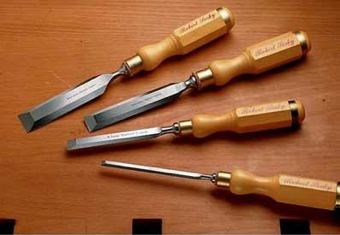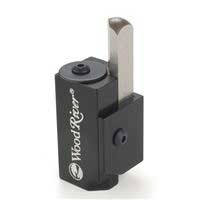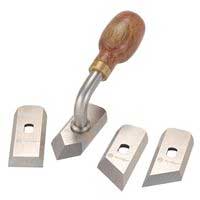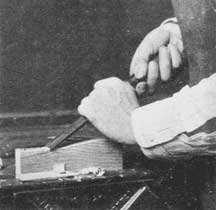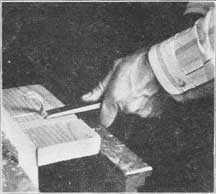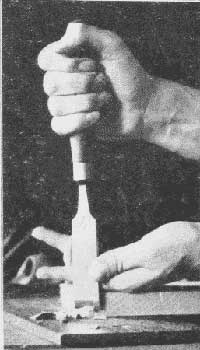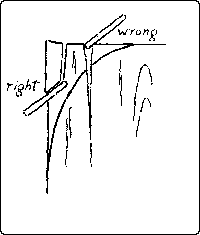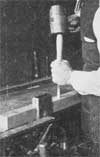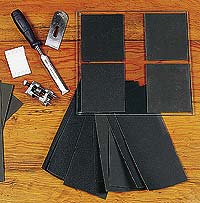
|
Wood Chisels
Cutting Edge
Bevels are typically ground to 25 degrees for paring, while mortice chisels need 35 degrees or more for heavy chopping. A sharp chisel is a safer chisel to work with because it requires less force so is easier to control. Chisel Steel
Toughness in steel is the most important characteristic so the edge does not wear quickly. It needs to be hard enough to hold an edge for a long time, unfortunately brittleness also comes with hardness. When a brittle blade is pounded into a dense wood the thin metal fractures, leaving a jagged edge. Another consideration is that the steel must not be so hard that it is difficult to sharpen. Handles
Plastic handles are normally fitted to general-purpose chisels aimed at the home handyman, they are serviceable and good to have for heavy chopping. With a metal ring or ferrule fitted to the top of the chisel handle you can use a metal hammer for light taps that provides a sharper, less massive force with more control over the depth than a heavy wooden mallet.
Corner Mortising Chisel
This tool is used to square the corners of mortises for hinges made with a router, just a tap with a hammer neatly cuts out the corner. Chisel Plane
Although not truly
either, the offset handle permits the short chisel blades to glide
along the surface like a plane removing excess dried glue with ease;
cleaning out corners; trimming protruding dowels or pegs and who knows
what else!
Working with Chisels In general, there are two uses for the chisel (1), when it is driven by a push with the hand, as in paring, and (2), when it is driven by blows of a mallet, as in digging mortises.
In relation to the grain of the wood, it is used in three directions: (1) longitudinally, that is with the grain, called paring; (2) laterally, across the surface, called cutting sidewise; (3) transversely, that is across the end, called cutting end-wood.
1. Paring. To remove shavings rapidly, the chisel is held flat side up, the handle grasped by the right hand, with the thumb pointing toward the shank, and the blade held in the left hand, as shown above. Held in this way great control can be exerted and much force applied. For paring the surface as flat and smooth as possible, the chisel should be reversed, that is, held so that the flat side will act as a guide.
2. In sidewise chiseling the chisel is held in the same manner as in paring. A typical form of sidewise chiseling is the cutting out of a dado, see above. The work may be placed on the bench-hook or held in the vise with the side up from which the groove is to be cut. The chisel is pushed directly across the grain, the blade being somewhat inclined to the upper surface so as to cut off a corner next the saw kerf. After a few cuts thus made with the chisel inclined alternately both ways, the ridge thus formed is taken off. In this way the surface is lowered to the required depth. If more force be required, the palm of the hand may be used as a mallet.
3. In chiseling end-wood, it is well, if possible, to rest the piece to be trimmed flat on the cutting board or on a piece of waste wood. Work done in this way is often called perpendicular chiseling. The handle is grasped in the right hand, thumb up, while the blade of the chisel passes between the thumb and first finger of the left hand, the back of which rests on the work and holds it in place. As the right hand pushes the chisel downwards the thumb and first finger of the left hand control its motion. When chiseling it is well to stand so as to look along the line being cut. Incline the chisel toward you, and use the near part of the cutting edge for a guide and the farther corner for cutting, pushing the handle both down and forward at the same time. Or, by pushing the chisel sidewise with the thumb of the left hand at the same time that the right hand pushes it downward, the effective sliding cut is obtained. End chiseling requires considerable force and therefore only thin shavings should be cut off at a time. Or the mallet may be used with caution. In order to leave a smooth surface the chisel must be very sharp. Even then the lower arris (corner) is likely to be splintered off. This can be prevented by clamping the work down tight with a handscrew to a perfectly smooth cutting board. It is often advisable however, to set the piece upright in the vise and pare off thin shavings horizontally. In rounding a corner, both this and perpendicular chiseling are common methods. In both cases care should be taken to cut from the side toward the end and not into the grain, lest the piece split. In horizontal end paring in order to prevent splintering, it is well to trim down the arrises diagonally to the line and then to reduce the rest of the end surface. In all hand chiseling, it is a wise precaution not to try to cut out much material at each stroke but to work back gradually to the line.
When cutting a pocket for a hinge a backing block clamped to the back of the material will help to avoid splitting the thin lip. Sharpening Chisels
|
